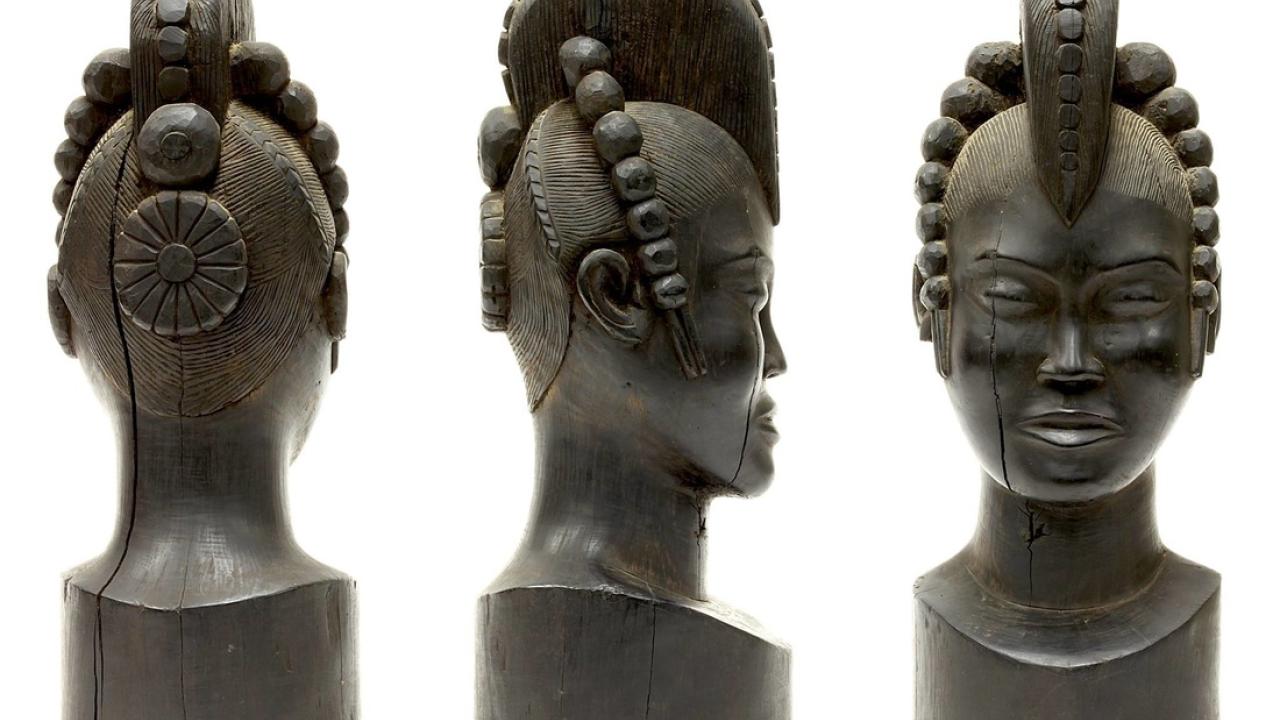
May 21, 2015: Ebony Bust
Equatorial Africa, mid-20th Century
39 x 15 x 16 cm
Sculpture is a long and vibrant tradition in equatorial Africa, employing an array of mediums, including bronze, stone, ceramic, ivory, and wood. This bust of a woman is made from ebony (Diospyros sp.), a tree with beautifully dark heartwood dense enough to sink in water. Ebony has been a highly prized wood used anciently, as evidenced by 5,000 year old carved pieces found in Egyptian tombs; historically, as in the “ebony” keys of pianos; and modernly, a prized wood for fretboards, pool cue butts, and a variety of boxes and handles. Deforestation and over-logging have threatened and endangered many ebony species and a number of regional bans on the export of ebony are now in effect.
Sculptures in equatorial Africa were not only considered to be works of art, but often possessed religious and social significance to the community. A finished sculpture could have certain religious powers bestowed to it by a trained individual with a connection to the spirit world. This could be used a means to ward off evil spirits and disease, bring good harvest and heavy rain, or bring fertility and fortune. In the cultural ontology, spiritual statues are better thought of as dwellings in which spirits could reside, instead of being considered idols in their own right. Statues could thus house spirits of ancestors or spirits that influenced the natural world when appropriately prepared.
From an art history perspective, African sculpture is a diverse and long-running artistic tradition. African art was a major influence to European art beginning with Portuguese sailors who brought back African art as proof of their voyages in the late 16th century. African artist applied their techniques and traditions to new forms, such as salt cellars, in the prosperous port cities of West Africa. This cultural exchange was not necessarily one of mutual understanding, however. The British military expedition to Benin in 1897, widely cited as a major event in bringing African art to European consumers, was the result of the looting of Benin City by British forces during a hostile invasion following trade disputes and a growing interest in colonial possessions by the British crown.
In the early 20th century, aesthetics of African sculpture influenced the development modern art. Artists from the School of Paris, including Pablo Picasso and Henri Matisse, drew from the highly stylized forms of African sculptures, blending them with post-Impressionist aesthetics, to create Cubism. Picasso’s African Period (1906-1909) was sparked by a visit to an ethnographic museum in the Palais du Trocadéro. Not only did the high three-dimensionality of African art influence the two-dimensional European tradition, but European sculpture was influenced as well. The sculptor and painter Amedeo Modigliani drew upon African sculpting forms in his own sculptures, mimicking the African tradition, as well as in his characteristic paintings of the elongated human form.
This piece from “Equatorial Africa,” donated to the museum in 1963, shares a common problem with many ethnographic collections donated to museums from private collections in that it lacks meaningful provenience information. While its appearance suggests that it was likely made for sale in the 20th century, documentation about who it was collected from and where was not preserved. A good practice in art collection, as with ethnographic material, is to keep track of as much information about the object as possible and to carefully maintain that documentation. If your masterpiece ever ends up in a museum someday, your efforts will be greatly appreciated.